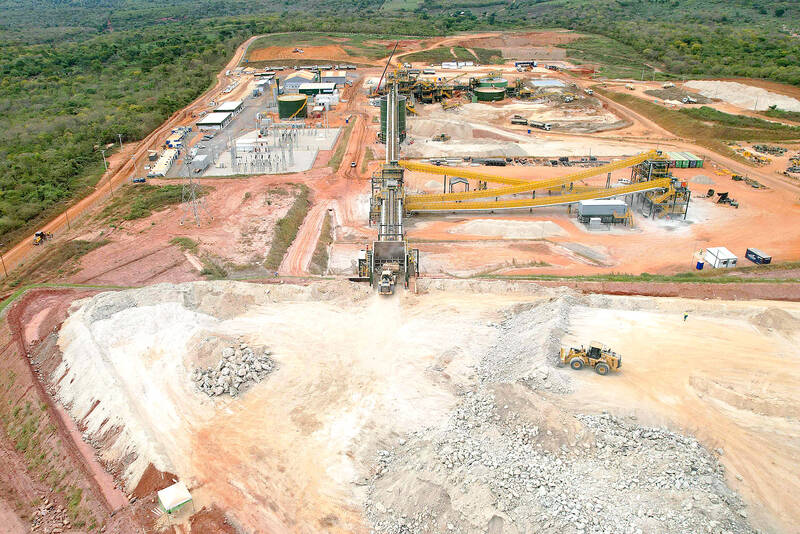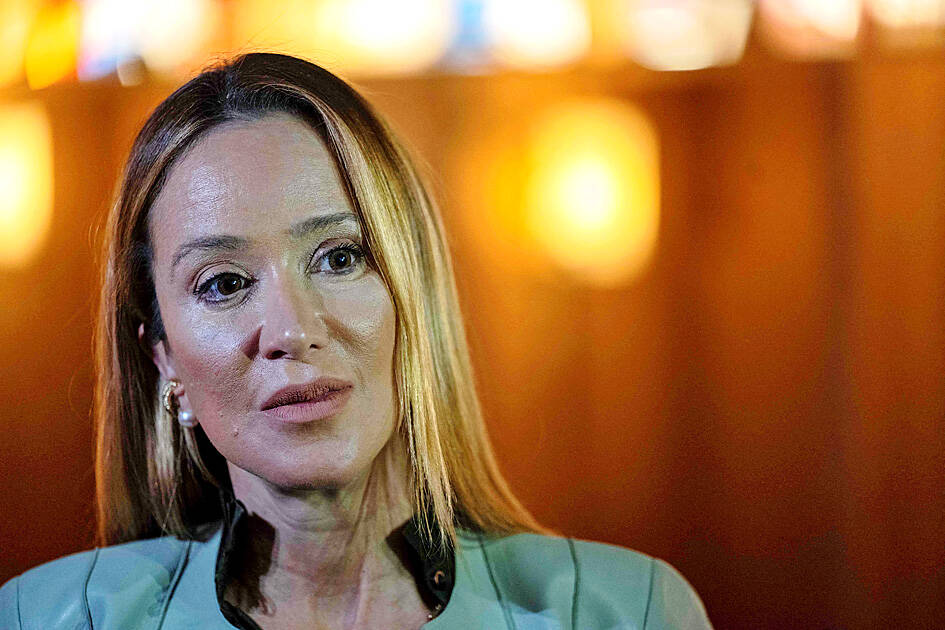In a cloud of gray dust, a heavy-duty excavator loaded a truck with stone blocks containing lithium, the “white gold” of the clean-energy revolution, which some hope would transform this parched, impoverished region of Brazil.
Sun-scorched and drought-prone, the Jequitinhonha Valley, in the southeastern state of Minas Gerais, is one of the poorest places in the country.
However, the region, nicknamed “misery valley,” is on the cusp of a boom: It is home to about 85 percent of the lithium reserves in Brazil, the world’s fifth-biggest producer of the metal, an essential ingredient in electric vehicle batteries.

Photo: AFP
Authorities in the region are eager to tap the potential of the silvery-white metal.
Last month they threw a fanfare-filled event at the NASDAQ stock exchange’s headquarters in New York, where they launched an initiative to attract investment to what they are calling “Lithium Valley.”
However, not everyone is thrilled at the idea.

Photo: AFP
Some residents in the region of about 1 million people complain about the environmental impact of lithium mining, others that local communities are not being included.
“This is the Jequitinhonha Valley... They want to call it ‘Lithium Valley.’ But let’s not put mining interests before our people’s identity,” said Aline Gomes Vilas, 45, a local activist in the town of Aracuai.
Ana Cabral-Gardner, chief executive of Canadian mining firm Sigma Lithium, is keen to respond to such criticism.
Her company, which started mining in the valley in April, is among the first to tap its lithium reserves.
Its goal is to produce more than 600,000 vehicle batteries’ worth of the metal in its first year, eventually scaling up to three times that amount.
Sigma calls itself a “green lithium” miner, and emphasizes its social and environmental credentials.
Lithium mining is notoriously water-intensive, a problem given that the metal is typically found in water-poor regions.
Cabral-Gardner, who is Brazilian, said her company reuses 90 percent of its water supplies, protects the local stream and uses no chemicals in the mining process.
“Our entire operation is built around finding a balance between sustainability and mining,” she told reporters. “I’ve been called the ‘hippie CEO.’”
In Aracuai, which sits near Sigma’s mine, Gomes Vilas said it is already having a negative effect, including damage to people’s homes from explosions used in the mining process.
“This was a peaceful rural area. Now there’s a constant racket. There are already houses with cracks in the walls from the explosions,” she said.
“The whole house shakes every time there’s an explosion,” added Luiz Gonzaga, a 71-year-old farm worker who lives next to the mine. “They’re digging pretty far from me for now, and the dust is already bothering us. Imagine what it will be like when they start digging closer.”
Brazil, a country with a history of rapacious resource booms and busts, needs to ensure communities like this benefit from lithium mining, advocates have said.
“The Jequitinhonha Valley has been through a gold rush, a diamond rush and it never brought development,” said Ilan Zugman, Latin America director for environmental group 350.org.
“We obviously believe the clean-energy transition needs to happen, but it should be fair and inclusive for local communities,” he said.
So far, the lithium mined in Brazil is almost entirely exported — not a good sign, said Elaine Santos, a researcher at Sao Paulo University.
“Look at Europe and the United States: They have a strategy to develop the entire value chain of electric cars, from mining to vehicle production,” she said.
“Brazil’s policy is still very limited... Brazil risks deepening its dependency as a country that just exports raw materials, with little added value,” she added.

‘UNUSUAL EVENT’: The Australian defense minister said that the Chinese navy task group was entitled to be where it was, but Australia would be watching it closely The Australian and New Zealand militaries were monitoring three Chinese warships moving unusually far south along Australia’s east coast on an unknown mission, officials said yesterday. The Australian government a week ago said that the warships had traveled through Southeast Asia and the Coral Sea, and were approaching northeast Australia. Australian Minister for Defence Richard Marles yesterday said that the Chinese ships — the Hengyang naval frigate, the Zunyi cruiser and the Weishanhu replenishment vessel — were “off the east coast of Australia.” Defense officials did not respond to a request for comment on a Financial Times report that the task group from

Chinese authorities said they began live-fire exercises in the Gulf of Tonkin on Monday, only days after Vietnam announced a new line marking what it considers its territory in the body of water between the nations. The Chinese Maritime Safety Administration said the exercises would be focused on the Beibu Gulf area, closer to the Chinese side of the Gulf of Tonkin, and would run until tomorrow evening. It gave no further details, but the drills follow an announcement last week by Vietnam establishing a baseline used to calculate the width of its territorial waters in the Gulf of Tonkin. State-run Vietnam News

DEFENSE UPHEAVAL: Trump was also to remove the first woman to lead a military service, as well as the judge advocates general for the army, navy and air force US President Donald Trump on Friday fired the chairman of the Joint Chiefs of Staff, Air Force General C.Q. Brown, and pushed out five other admirals and generals in an unprecedented shake-up of US military leadership. Trump wrote in a post on Truth Social that he would nominate former lieutenant general Dan “Razin” Caine to succeed Brown, breaking with tradition by pulling someone out of retirement for the first time to become the top military officer. The president would also replace the head of the US Navy, a position held by Admiral Lisa Franchetti, the first woman to lead a military service,

Four decades after they were forced apart, US-raised Adamary Garcia and her birth mother on Saturday fell into each other’s arms at the airport in Santiago, Chile. Without speaking, they embraced tearfully: A rare reunification for one the thousands of Chileans taken from their mothers as babies and given up for adoption abroad. “The worst is over,” Edita Bizama, 64, said as she beheld her daughter for the first time since her birth 41 years ago. Garcia had flown to Santiago with four other women born in Chile and adopted in the US. Reports have estimated there were 20,000 such cases from 1950 to